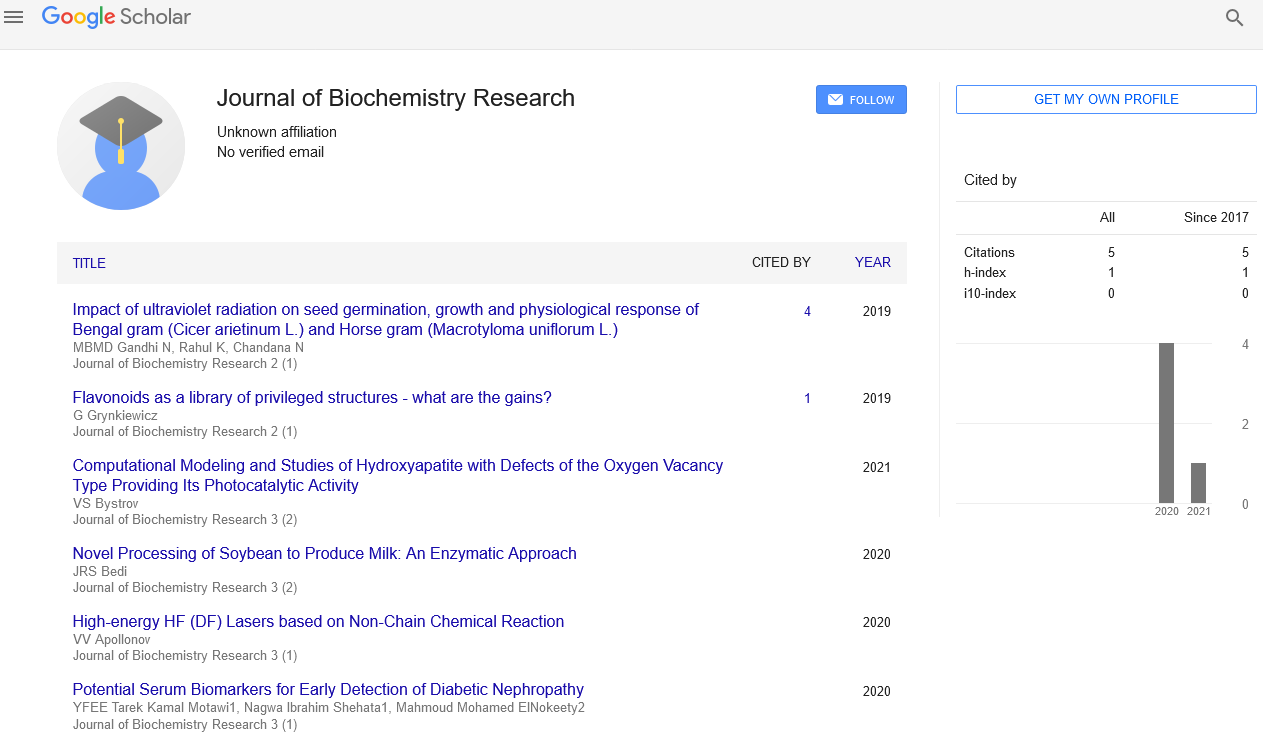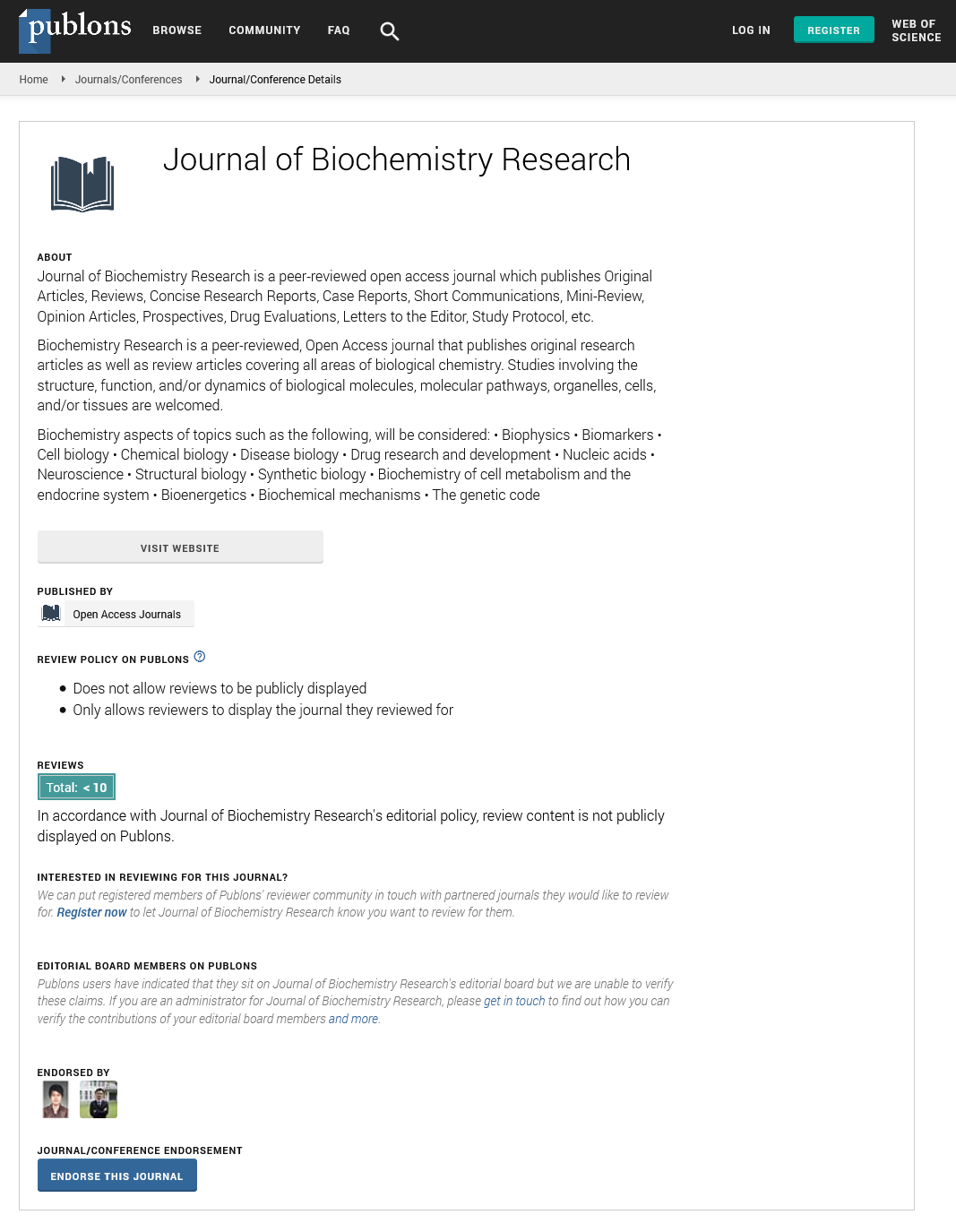Mini Review - Journal of Biochemistry Research (2023) Volume 6, Issue 1
Lipids: The Role of Lipid Metabolism and Lipidomic
Dr. Abdullah Mo. Khan*
Department of Biochemistry Research, University of COMSATS, Pakistan
Department of Biochemistry Research, University of COMSATS, Pakistan
E-mail: a.mo.khan@gmail.com
Received: 02-Feb-2023, Manuscript No. oabr-23-89001; Editor assigned: 06-Feb-2023, PreQC No. oabr-23- 89001; Reviewed: 20- Feb-2023, QC No. oabr-23-89001; Revised: 22-Feb- 2023, Manuscript No. oabr-23-89001 (R); Published: 28-Feb-2023; DOI: 10.37532/oabr.2023.6(1).04-06
Abstract
Fats and lipids are common ingredients in food and may have important functions. Their types may be more important than their numbers when it comes to health and disease. The purpose of this review is to provide a summary of the data regarding the impact that functional lipids have on human health. Numerous diseases can be prevented and treated with the help of functional lipids, according to recent research. Omega-3 and omega-6 fatty acids, conjugated linoleic acids, medium chain triglycerides, phytosterols, and other functional lipids have numerous beneficial effects on human health, including the treatment and management of depression, blood pressure, cardiovascular health, and obesity. The production of eicosanoids, which are the metabolites of these series of fatty acids, is controlled by the ratio of omega-3 to omega-6 polyunsaturated fatty acids. Supplemental and dietary forms of functional lipids have been shown to have positive effects on healthy individuals as well as encouraging improvements in patients. A growing body of research suggests that lipid metabolism plays a significant role in aging. Nematodes, fruit flies, mice, and rats all live longer thanks to numerous lipid-related dietary, pharmacological, genetic, and surgical interventions. For instance, both worms and flies can live longer if their genes for ceramide and sphingolipid synthesis are affected. Caenorhabditis elegans lives longer when fatty acid amide hydrolase or lysosomal lipase is overexpressed, while Drosophila melanogaster and C. elegans live longer when diacylglycerol lipase is overexpressed. Adipose tissue removal surgically increases rats' lifespan, and both flies and mice's survival is improved by an increase in apolipoprotein D expression. The genetic deletion of diacylglycerol acyltransferase 1, treatment with the steroid 17-estradiol, or a ketogenic diet can also extend the lifespan of mice. In addition, a progeria mouse model in which the phospholipase A2 receptor is deleted has better health span parameters. Human aging has been linked to a number of lipid-related variants, according to genome-wide association studies. Apolipoprotein E's epsilon 2 and epsilon 4 alleles, for instance, are linked to extreme longevity and neurodegenerative diseases with late onset. Triglyceride levels tend to rise in humans as they get older, while lysophosphatidylcholine levels tend to drop. It has also been demonstrated that certain sphingolipid and phospholipid blood profiles alter with age and are linked to exceptional human longevity. Blood lipids probably represent a rich source of human aging biomarkers and suggest that lipid-related interventions may extend human health spans.
Keywords
Functional lipids • Omega-3 fatty acid • Omega-6 fatty acid • Medium chain triglycerides • Conjugated linoleic acids • Phytosterols • Obesity • Bone health
Introduction
Foods can be considered functional if they aid in disease prevention and health maintenance. They might offer a way to lessen the growing strain on the healthcare system. Functional lipids can be loosely defined as a subset of functional foods that have been shown to have physiological benefits and/or reduce the risk of chronic disease beyond basic nutritional functions [1]. Although there is no official definition, functional lipids are considered to be similar to conventional foods that are consumed as part of a typical diet. The objective of this review is to provide a synopsis of the information that is currently available regarding a few functional lipids. The majority of our data on aging and lifespan come from shorter-lived yeast, worms, flies, and rodents due to the inordinate amount of time and money required to validate a study in humans [2]. Only a small amount of aging research has been done on organisms with longer lifespans, with the exception of studies showing that restricting calories improves health and survival in rhesus monkeys. Genetic experiments on model organisms account for the majority of our understanding of aging, but we do not yet know how similar or distinct human aging is. For instance, genome-wide association studies looking for longevity-related variants have found that not many genes that are known to extend lifespan in simpler animals are associated with them [3].
This is probably because of the significant biological differences that exist between these organisms and humans, in addition to the limited genetic diversity of strains of laboratory animals. As a result, it is likely that many of the aging interventions that have been demonstrated in the laboratory will not have significant clinical effects on humans [4].
Lipidomic Analyses of Extreme Human Longevity
A few studies have examined the connection between aging and a wide range of different lipids through a comprehensive lipidomic analysis. For instance, 19 lipid species were previously associated with familial longevity in women after being measured by mass spectrometry and liquid chromatography on 128 lipid species [5]. The plasma lipidome of nonagenarian offspring was compared to that of nonagenarian controls by the authors. Female offspring had higher levels of either sphingomyelin or phosphocholine species, as well as lower levels of long-chain triglycerides and phosphoethanolamine, but there were no significant differences between male and female offspring [6]. Additionally, longevity was linked to a higher proportion of MUFAs to PUFAs. Interestingly, the ratio of PUFA to MUFA is lower in many long-lived organisms or mutants. Using NMR metabolomics and shotgun lipidomics, two separate studies discovered that centenarians and elderly controls exhibit distinct changes in biosynthesis [7]. Putative markers and modulators of healthy aging, in particular, were identified as sphingolipids and phospholipids. A fatty acid profile that is resistant to lipid peroxidation has been linked to extreme longevity in recent lipidomic studies. Saturated and unsaturated fatty acids, like PUFAs, were found to have a lower impact on longevity than saturated fatty acids [8]. A longer average fatty acid chain length was also correlated with longer lifespans. Additionally, the authors proposed that biomarkers of extreme longevity could be found in particular ceramide lipid species. Using lipidomics, even more recently, Wong et al. discovered that their “oldest old” subjects over the age of 95 had globally low lipid levels. Plasma lipid levels differed between men and women based on age as well. LDL cholesterol, HDL cholesterol, and total cholesterol, for instance, were all higher in women. Females also had higher levels of docosahexaenoic acid-containing phospholipids and sphingomyelin [9].
These few studies have shared findings, despite the fact that additional research and data are required to better comprehend how the lipidome changes with age. Sphingomyelin levels in women rise with age, according to two different lipidomic tests. According to two of these papers, lower levels of unsaturated fatty acids are linked to human longevity, and sex-specific age differences in lipid content were found in two other studies. Sphingolipids were linked to aging in all three studies. In order to gain a deeper comprehension of the additional plasma lipids that change with age and the unique changes that plasma lipids undergo in men and women, more comprehensive lipidomic screenings are required [10].
Conclusion
Although there are still a lot of unanswered questions, it is abundantly clear that lipid metabolism plays a crucial role in controlling the aging process. In a variety of model organisms, interventions involving lipids have the ability to alter lifespan. Additionally, it has been demonstrated that certain lipids and lipid-related molecules increase or decrease with age. Last but not least, exceptional human longevity and genetic markers related to lipids may have a strong correlation. These characteristics demonstrate unambiguously that lipid metabolism is intimately linked to aging, exceeding the criteria for a characteristic of aging. In addition, they draw attention to a number of distinct potential pathways that could be targeted to extend human health span. It would be fascinating to learn what aging mechanisms are shared between each of these targets when they impact longevity, as many of our proposed target pathways overlap.
In the future, it should be the goal of research to learn more about the mechanisms by which model organisms’ lifespans change in response to specific lipid-related interventions. It is especially important to conduct additional research using vertebrate models like African turquoise killifish, mice, rats, and Rhesus monkeys. Prolongation lipid pathways could also be better understood by identifying unique lipid characteristics shared by animals with extreme longevity or theoretical immortality. Comprehensive analyses of health span parameters and the prevalence of age-related diseases in patients receiving lipidrelevant pharmacological interventions or genetic mutations related to lipids would be another strategy. This would aid in the identification of goals and treatments that could specifically be used to extend human health spans.
Additionally, we believe that lipid signatures have the potential to be made into reliable biomarkers that can accurately predict human biological age. Large human cohort studies are currently a bottleneck, despite their useful predictive power, and it might be beneficial to consider alternative study designs. Reanalysing data may help uncover new information from existing datasets in the event that data sharing becomes more common. Utilizing the numerous apps that are available to track daily activity, composition, and food intake could be an alternative experimental strategy. In order to study lipids and aging or aging-related health outcomes in large human datasets, various measurements could be combined with the recruitment of individuals to document daily intake of specific food compounds. We believe that certain lipid-related interventions have the potential to extend human health spans based on the available data.
Acknowledgement
None
Conflict of Interest
None
References
- Sheard NF, Clark NG, Brand-Miller JC et al. Dietary carbohydrate (amount and type) in the prevention and management of diabetes: a statement by the american diabetes association. Diabetes Care. 27: 2266-71 (2004).
- Chandalia M, Lutjohann D, von Bergmann K et al. Beneficial effects of high dietary fiber intake in patients with type 2 diabetes mellitus. N Engl J Med. 342: 1392-8 (2000).
- Schwartz SE, Levine RA, Weinstock RS et al. Sustained pectin ingestion: effect on gastric emptying and glucose tolerance in non-insulin-dependent diabetic patients. Am. J. Clin. Nutr. 48: 1413-7 (1988).
- Simó R, Hernández C. Treatment of diabetes mellitus: general goals, and clinical practice management. Revista Espanola de Cardiologia. 55: 845-860 (2002).
- Makam AN, Nguyen OK. An Evidence-Based Medicine Approach to Antihyperglycemic Therapy in Diabetes Mellitus to Overcome Overtreatment. Circulation. 135: 180-195 (2017).
- Qaseem A, Vijan S, Snow V et al. Glycaemic control and type 2 diabetes mellitus: the optimal haemoglobin A1C targets, a guidance statement from the American College of Physicians. Annals of Internal Medicine. 147: 417-422 (2007).
- Brown AF, Mangione CM, Saliba D et al, Guidelines for improving the care of the older person with diabetes mellitus. Journal of the American Geriatrics Society. 51: 265-280 (2003).
- Adams DD, autoimmune destruction of pericytes as the cause of diabetic retinopathy. Clinical Ophthalmology. 2: 295-298 (2008).
- Huang ES, Brown SE, Ewigman BG et al. (2007) Patient perceptions of quality of life with diabetes-related complications and treatments. Diabetes Care. 30: 2478-2483.
- Buehler AM, Cavalcanti AB, Berwanger O et al. (2013) Effect of tight blood glucose control versus conventional control in patients with type 2 diabetes mellitus: a systematic review with meta-analysis of randomized controlled trials. Cardiovascular Therapeutics. 31: 147-160.
Indexed at, Google Scholar, Crossref
Indexed at, Google Scholar, Crossref
Indexed at, Google Scholar Crossref
Indexed at, Google Scholar, Crossref
Indexed at, Google Scholar, Crossref
Indexed at, Google Scholar, Crossref
Indexed at, Google Scholar, Crossref
Indexed at, Google Scholar, Crossref


